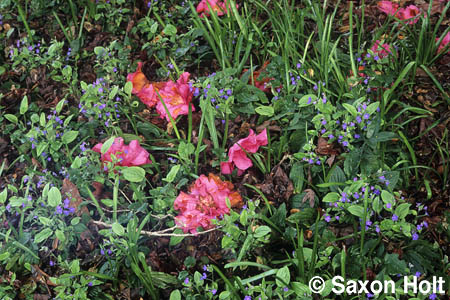It has been 3 weeks since I posted to my blog. I have the blog blahs. Thank goodness I am not a professional writer who must write, inspired or not. Or maybe if I were a professional writer it would be easier to get into the habit of writing something so simple and unconditional as a blog.
I have something deep inside waiting moderation of my soul. Poetry, gardening, life, joy. It is welling up awaiting permission to annotate. In the meantime a photo lesson.
I do not take as many close-up photos as many garden photographers. I probably should as there is a larger market for them than the wider photos. The wider photos reveal more about a garden and the connection of the plants to the world.
These camellia blossoms on the garden floor nestled among the forget-me-nots say a lot about a gardening moment to me. The photo connects to a much wider garden we can only imagine but is implicit seeing these plants together. It speaks much more to a gardener than any other viewer, and is why I love garden photography. My viewers are predisposed to like what I like.
This is a good photograph about gardening. It captures a moment in this garden that needs no caption, a caption that might lock the viewer into a single interpretation. I think a good photo asks the viewer to become engaged. Giving it a definition can stop the engagement and curiosity.
A good photograph captures a visual symbol, finds in a fleeting moment, and if successful allows the viewer to pause and get into the moment themselves. A superior photo also has strong compsition, tonal range, fresh insight, and and poses a question. A superlative photo has all this and stands the test of time.
I don’t pretend this photo is superlative or even superior. It was chosen as a good one and one that leads to another photo as the photographer becomes curious himself about why the scene is so interesting. It was also chosen for a lesson about close-up photography.
Whenever we stumble across a garden scene that wants us to frame it up in a camera, before taking the picture, ask yourself what you are trying to say. What to do you see ? How can the camera help communicate it ? In the above picture I saw a lot: a complex story about a winter scene in a zone 9 California garden, a manicured estate garden, Filoli. A fabulous statement about plants growing together, about decay, about winter and spring at the same time, about color, about the transitory nature of gardens.
But you know what else I saw about plants and color as I looked closer ? I saw a close-up photo:

Omphalodes cappadocica in spring garden with Camellia blossom
Just plain pretty. Needs no explanation.

